Exhibit Room C: Francis R. Bradford Sphere Collection
Introduction
Text-to-speech Audio
The Francis Robert Bradford Sphere Collection includes almost 120 polished spheres of geological specimens from all over the world. Francis Robert Bradford attended Waynesburg College and studied geology under Dr. Paul R. Stewart. Bradford graduated in 1939 and spent more than 30 years creating this collection. The collection was displayed for a time at Hennen Jewelers in the Ft. Jackson Hotel in Waynesburg, PA. In the 1990s Bradford donated the collection to the Paul R. Stewart Museum at Waynesburg University.
Images
Francis Robert Bradford
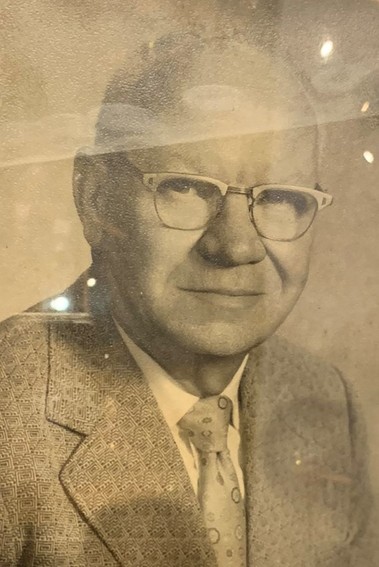
Stages of making a sphere.
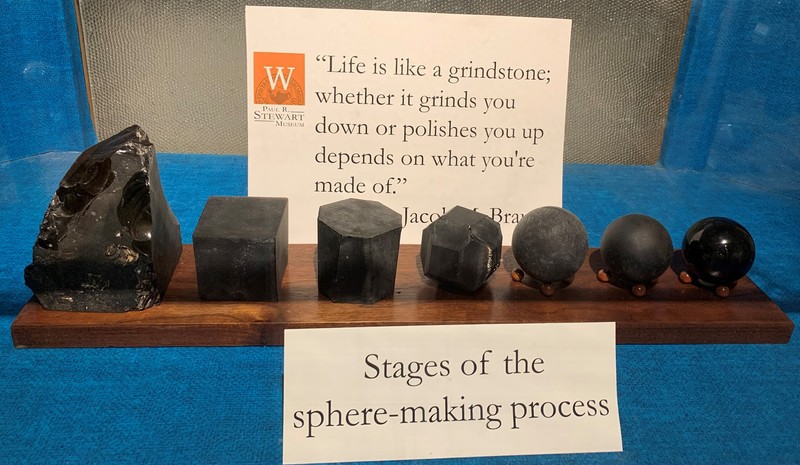
Francis Robert Bradford's diploma on display at the Paul R. Stewart Museum.
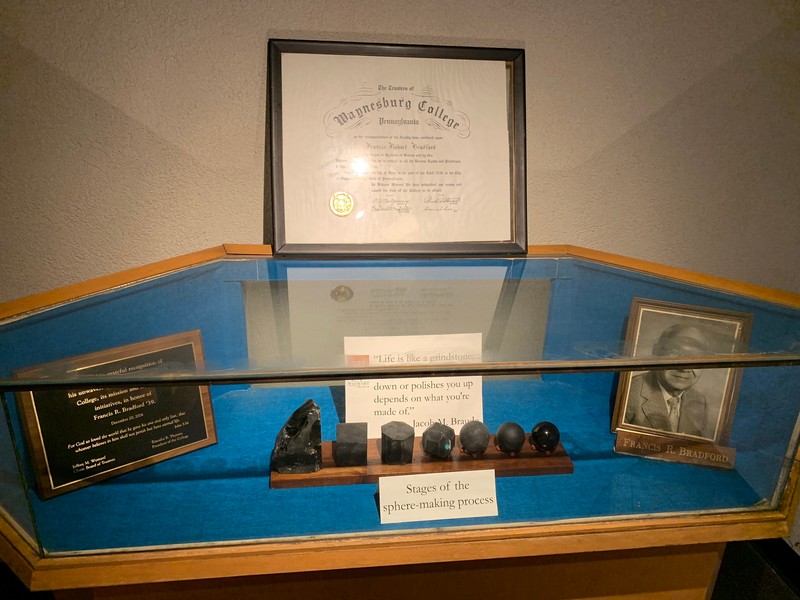
Case A: Brecciated Jasper // Jasper is an opaque type of Chalcedony (a finely crystalline form of silica composed of quartz and moganite) that can be found in many locations around the world. Jasper is most commonly thought of as red or brown, but can feature many colors including green, yellow, Black, and rarely blue. It is almost always multicolored with different patterns resulting from how the silica consolidated during its formation. Breccia refers to a process when large, broken, and/or angular fragments of rock and mineral accumulate and form a sedimentary rock of large fragments cemented together with smaller particles and mineral cement.
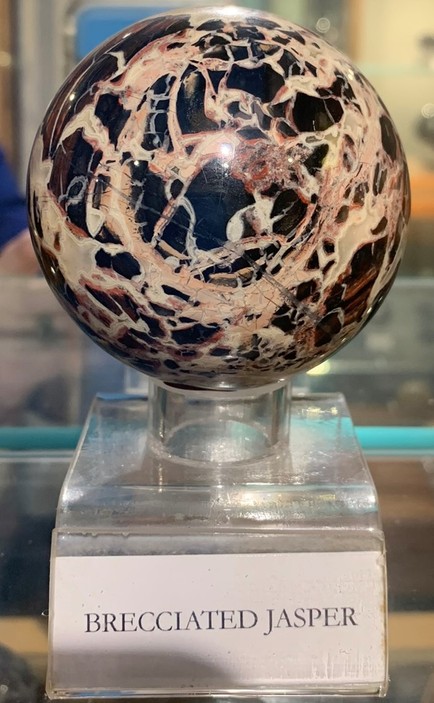
Case A: Mozarkite // Mozarkite is the official state rock of Missouri, adopted in 1967, and it is only found around Benton County, Missouri. It is a type of sedimentary rock known as a chert that typically appears as red, pink, or purple. The name combines the state’s abbreviation “MO” with “Ozark,” a region that covers much of the state (The Ozark Mountains and Ozark Plateau). The suffix “ite” means “of or pertaining to.”
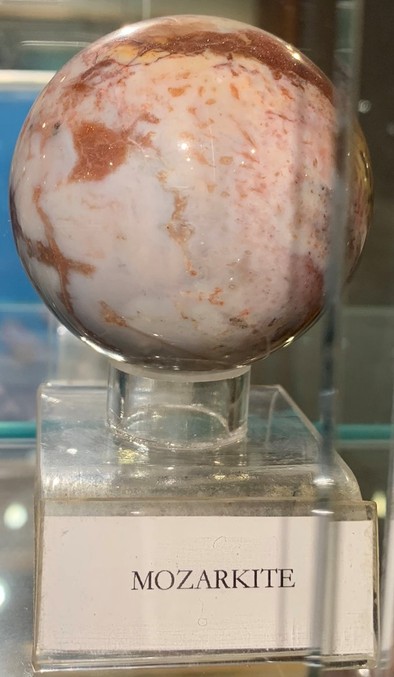
Case A: Ruby Zoisite // Also known as “ruby in zoisite” and Anyolite. Ruby Zoisite consists of green zoisite with red ruby crystals and Black crystals of the hornblende, tschermakite. Zoisite is formed when metamorphic and sedimentary rocks undergo the process of metamorphism (change caused by fluids passing through the rock) and hydrothermal alteration (when change is caused by hot water which alters minerals and forms veins). This mineral was first discovered in the district of Longido in Tanzania by Tom Blevins in the 1940s and it can also be found in India and Zambia.
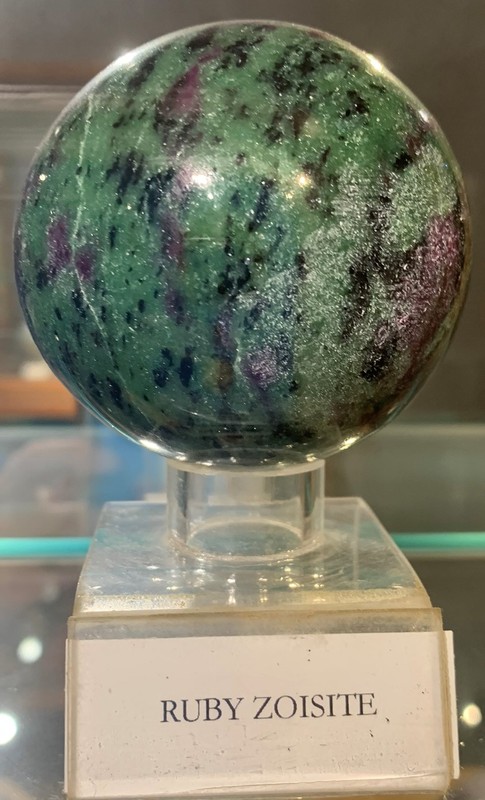
Case A: Binghamite, Hematite // Binghamite is a type of agate quartz only found on the Cuyuna Range in Minnesota near deposits of iron ore. It typically has fibers of goethite or hematite, like this sphere, and looks red, gold, and Black. Hematite is an iron oxide that is very abundant all over the globe and is the most important iron ore. Binghamite was named after William Bingham who discovered it in 1936.
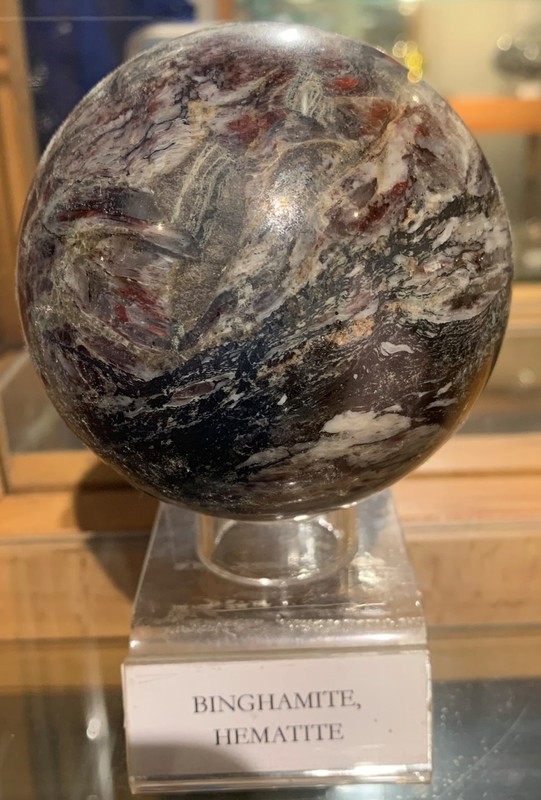
Case A: Wonderstone // Wonderstone is a “tuff,” or a type of igneous rock that forms after a volcanic eruption as ejected rock, ash, and other materials fall back to the ground and cement into new rock. The various bands of wonderstone are created when dissolved minerals in ground water flow through the rock and stain it different colors.
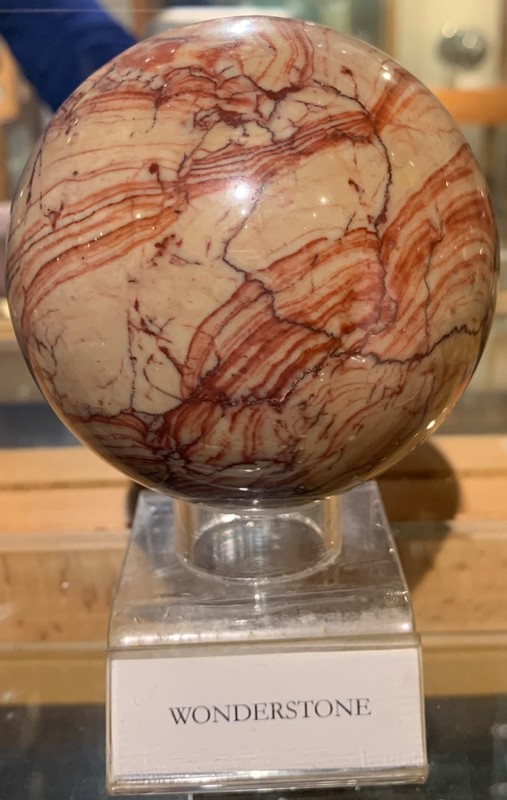
Case A: Hickoryite // Hickoryite is a type of Rhyolite, a high-silica rock formed from eruptions of granitic magma, which are rare. Hickoryite is from Rodeo, in the State of Durango, Mexico and has red, pink, and yellow bands. The name comes from its resemblance to hickory wood.
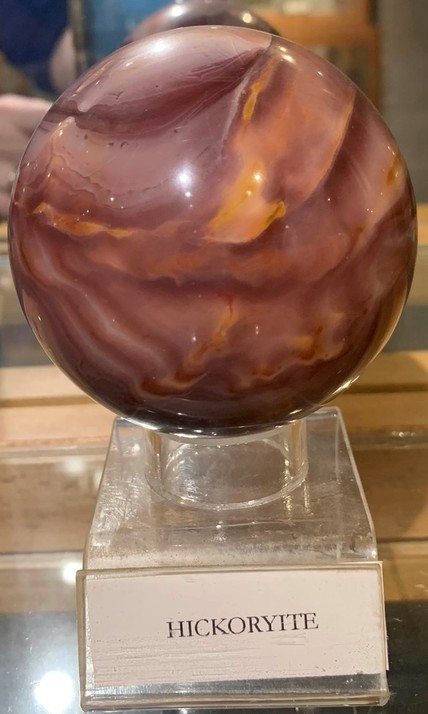
Case A: Tinterite //
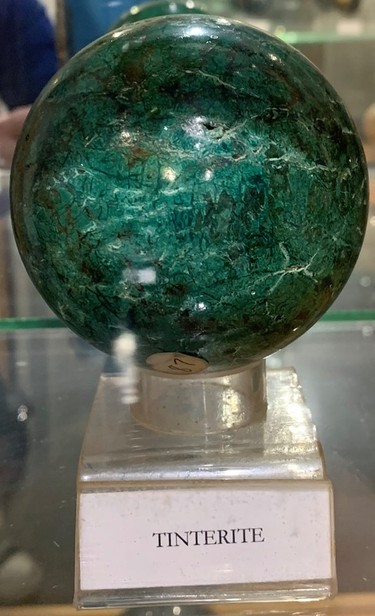
Case A: Onyx // Onyx refers to a chalcedony (a finely crystalline form of silica composed of quartz and moganite) that has parallel bands in alternating colors. Commonly onyx is either Black with white banding or red with white banding (called sardonyx). Onyx has been historically used for carving and jewelry, particularly cameos.
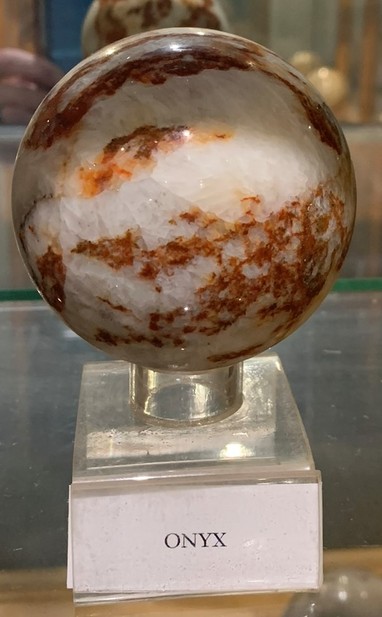
Case A: Mariposite // The name “mariposite” is typically used for green micas colored by amounts of chromium or a type of metamorphic rock that is green and white and contains large amounts of green mica. The name originates from Mariposa, California. During the California Gold Rush of the mid-1800s miners sought mariposite rocks because they were often a source of gold.
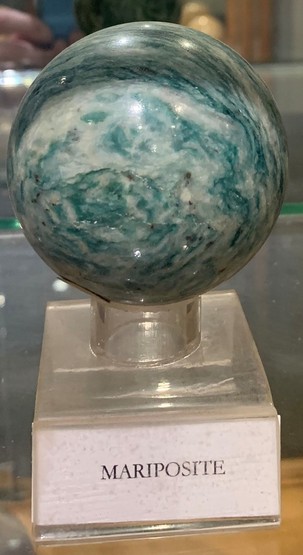
Case A: Grunerite // Grunerite occurs in iron-rich rocks that have experienced moderate metamorphism (alteration by heat or pressure). Grunerite crystals typically form as fibers or columns and are monoclinic prismatic (monoclinic meaning that the crystal forms as a rectangular prism with a parallelogram base and prismatic refers to its type of symmetry).
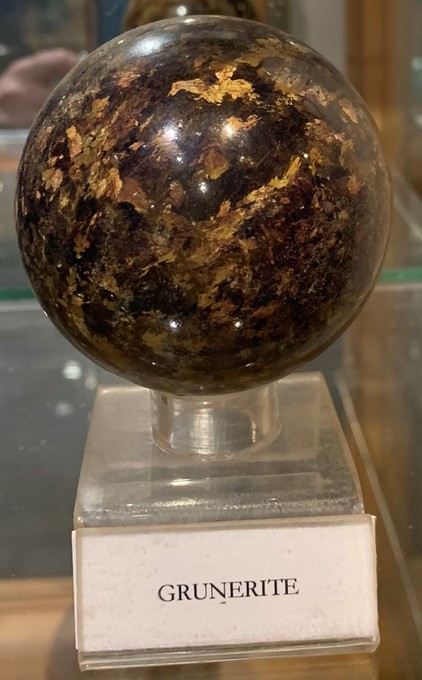
Case A: Fossil Limestone // Limestone is a type of sedimentary rock largely composed of calcite (calcium carbonate) that usually forms in warm and shallow marine waters. It is often a “biological sedimentary” rock, forming layers from organic debris such as shell and coral. Fossil, or Fossiliferous, Limestone features abundant fossils, typically marine invertebrates.
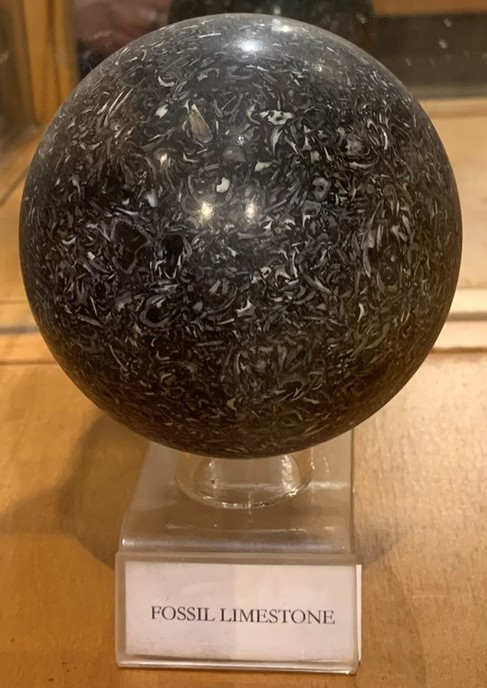
Case A: California Petrified Palm Wood // Petrified wood occurs when the organic material of a tree, in this case a type of palm, is replaced with stone. Minerals replace the organic material and replicates the structure of the original wood. This process occurs when wood is buried under volcanic ash or wet sediment. Petrified palmwood, called Palmoxylon, is silica-rich so it is popular for use in jewelry. In addition to the grain of the wood, Palmoxylon contains rod-like structures and depending on how the piece is cut these will appear as dots, lines, or tapering rods.
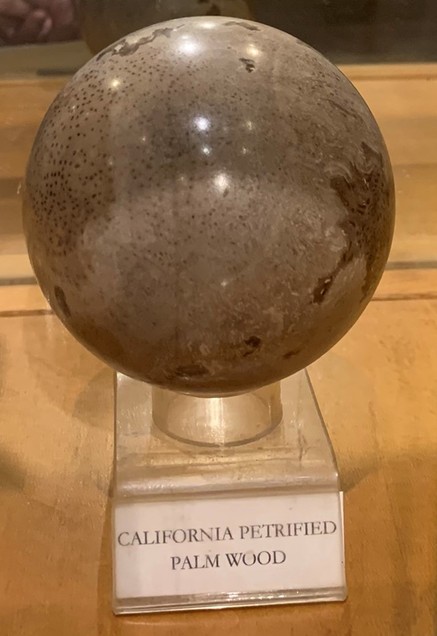
Case A: Onyx // Onyx refers to a chalcedony (a finely crystalline form of silica composed of quartz and moganite) that has parallel bands in alternating colors. Commonly onyx is either Black with white banding or red with white banding (called sardonyx). Onyx has been historically used for carving and jewelry, particularly cameos.

Case B: Malachite // Malachite is a green gemstone, a copper carbonate hydroxide mineral that has been used in jewelry and sculpted pieces and as a pigment. It is typically found as a stalactite or coating in caves because it forms in above copper deposits in the oxidizing zone and then drips down through fractures in the rock. Malachite was discovered over 4000 years ago in Egypt and Israel and was one of the first ores used to produce copper. It was also one of the oldest green pigments used in paintings, including paintings in Egyptian tombs.
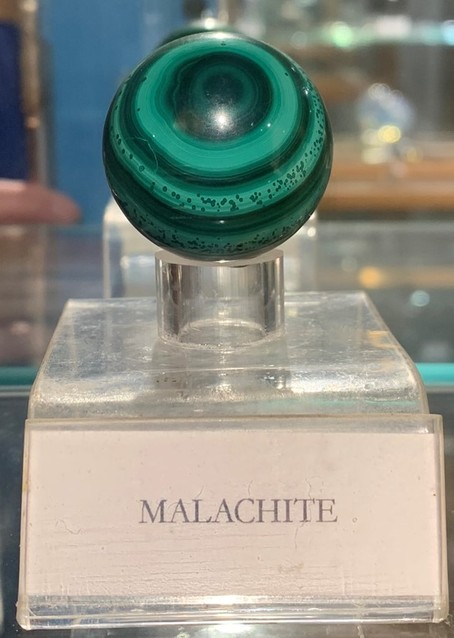
Case B: Fiber Optic Material // Optical fibers are made from molten silica glass (silicon dioxide)—the original manufacturing method in a crucible used highly purified silica powder while more modern methods use liquid silicon tetrachloride plus pure oxygen in a vapor deposition method. In this form where the glass fibers are fused together into a solid piece the stone exhibits chatoyance, or the “cat’s-eye effect.
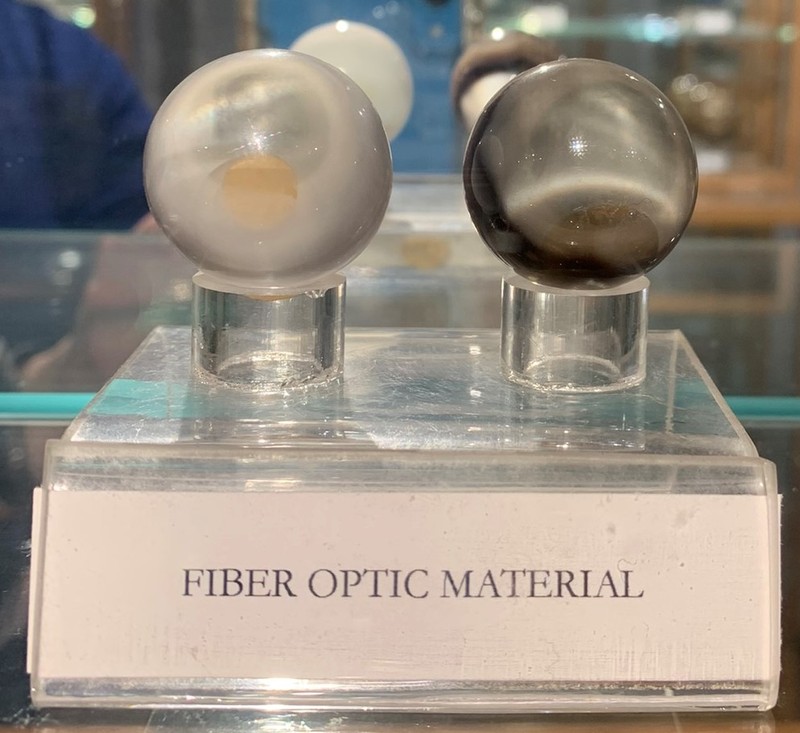
Case B: Rutilated Quartz // Rutile is a metallic ore mineral (titanium oxide) that is often found and mined from “heavy mineral sands” and used as an ore of titanium. It can also appear within other rocks and minerals—within gems like quartz the rutile forms long needles with a high luster.

Case B: Lizard Stone // Possibly a Lizard Stone Jasper or form of Serpentine.
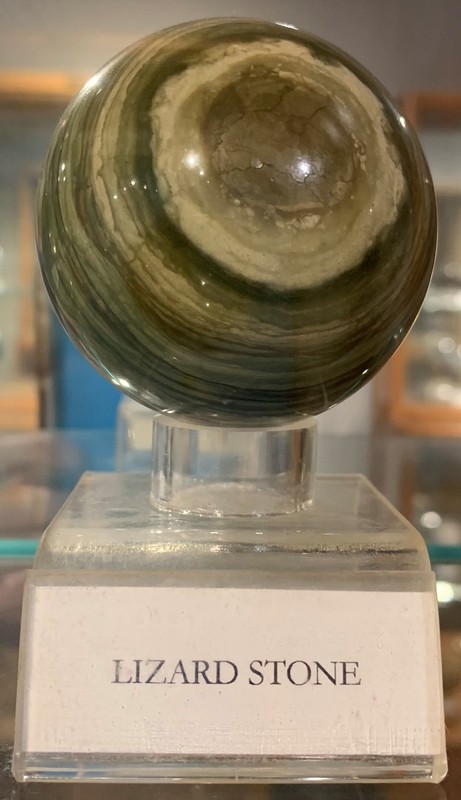
Case B: Serpentine // Serpentine is a group of minerals that includes primarily chrysotile, antigorite, and lizardite. Serpentine minerals form when ultramafic rocks (igneous rocks that compose most of the Earth’s mantle) undergo hydrothermal metamorphism (change caused by hot water passing through the rock, typically seawater in this case). Serpentine was named for its color, pattern, and slippery feel that reminded people of snakes and it is widely used for jewelry or sculpted pieces. Serpentine’s use is limited now, however, because its fibers are used in making asbestos, which has been linked to respiratory disease.

Case B: Copper Sheen Obsidian // Obsidian is a Black volcanic glass that forms when molten rock cools rapidly and it is typically found along the edges of a lava flow or where lava is cooled by air or water. Typically, Obsidian is a deep Black or will have a brown obsidian swirled in (known as “mahogany obsidian.” Rarely, obsidian has a metallic sheen that is caused by tiny particles of rock debris, gas, or mineral crystals. Depending on the sheen this obsidian is called “rainbow obsidian” if there are colors or golden, silver, or copper/bronze sheen obsidian.
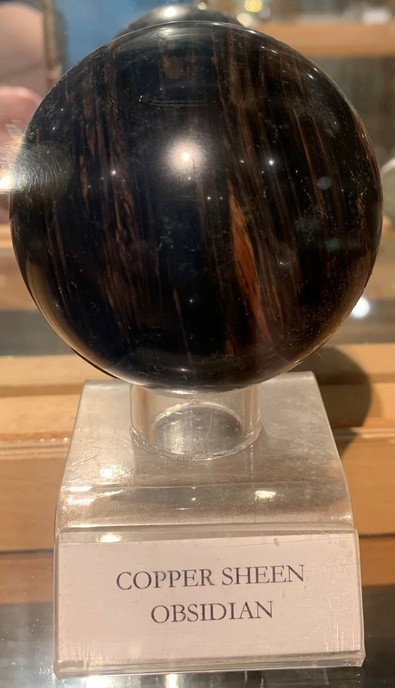
Case B: Silver Sheen Obsidian // Obsidian is a Black volcanic glass that forms when molten rock cools rapidly and it is typically found along the edges of a lava flow or where lava is cooled by air or water. Typically, Obsidian is a deep Black or will have a brown obsidian swirled in (known as “mahogany obsidian.” Rarely, obsidian has a metallic sheen that is caused by tiny particles of rock debris, gas, or mineral crystals. Depending on the sheen this obsidian is called “rainbow obsidian” if there are colors or golden, silver, or copper/bronze sheen obsidian.
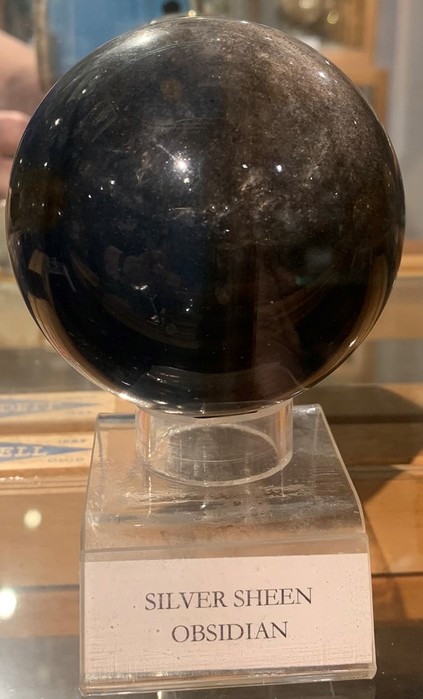
Case B: Brecciated Jasper // Jasper is an opaque type of Chalcedony (a finely crystalline form of silica composed of quartz and moganite) that can be found in many locations around the world. Jasper is most commonly thought of as red or brown, but can feature many colors including green, yellow, Black, and rarely blue. It is almost always multicolored with different patterns resulting from how the silica consolidated during its formation. Breccia refers to a process when large, broken, and/or angular fragments of rock and mineral accumulate and form a sedimentary rock of large fragments cemented together with smaller particles and mineral cement.

Case B: Australian Petrified Wood // Petrified wood occurs when the organic material of a tree is replaced with stone. This process occurs when wood is buried under wet sediment and the groundwater introduces materials such as silica, calcite, pyrite, or opal. Minerals replace the organic material and replicates the structure of the original wood.

Case B: Utah Petrified Wood // Petrified wood occurs when the organic material of a tree is replaced with stone. This process occurs when wood is buried under wet sediment and the groundwater introduces materials such as silica, calcite, pyrite, or opal. Minerals replace the organic material and replicates the structure of the original wood.

Case B: Bloodstone // Bloodstone is a type of chalcedony, a finely crystalline form of silica composed of quartz and moganite, that is typically dark green in color with red spots. The green coloring is thought to be from particles of chlorite, amphibole, and pyroxene while the typical red splashes are from iron oxide minerals. When colors other than red dominate the piece, such as in this example, it is called “fancy jasper.”
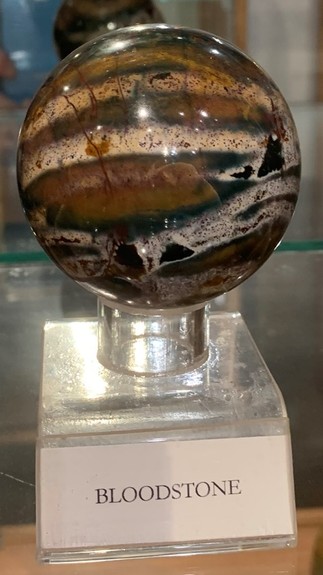
Case B: Bloodstone // Bloodstone is a type of chalcedony, a finely crystalline form of silica composed of quartz and moganite, that is typically dark green in color. This is an example of the more sought-after coloration of Bloodstone—predominately dark green with small spots of color. The highest quality of bloodstone has spots of red that are arranged in a pattern like a blood spatter. Previously this pattern was associated with the “Blood of Christ” and given religious meaning, which is where the name “Bloodstone” originated. Bloodstone has been used as a second birthstone for the month of March since 1912.
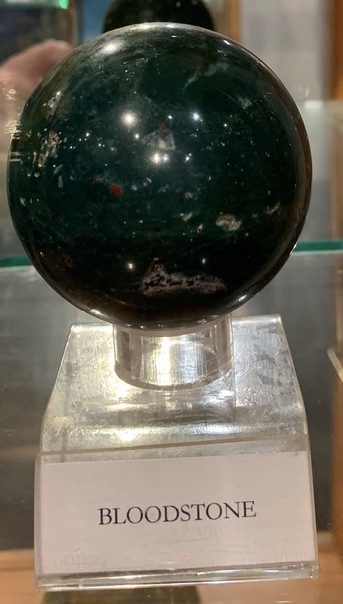
Case B: Thulite // Thulite is a type of zoisite, a type of mineral that forms as crystals after hydrothermal metamorphism and is usually only found in small quantities. Some zoisite is transparent, such as the popular tanzanite. Thulite is an opaque type of zoisite that is pink and very rare. Thulite is found in Norway, Namibia, Australia, and North Carolina (USA).

Case B: Rain Forest Jasper // Rain Forest Jasper is a type of rhyolite which is an igneous rock with a high silica content and very small grains. Gemstone deposits occur frequently in rhyolite—pockets of gas get trapped within the lava as it cools and this creates pockets (called “vugs”) that other materials can later fill to form minerals. Rainforest Jasper is a rare type of rhyolite found in Australia that features a mix of green, brown, red, and cream colors.
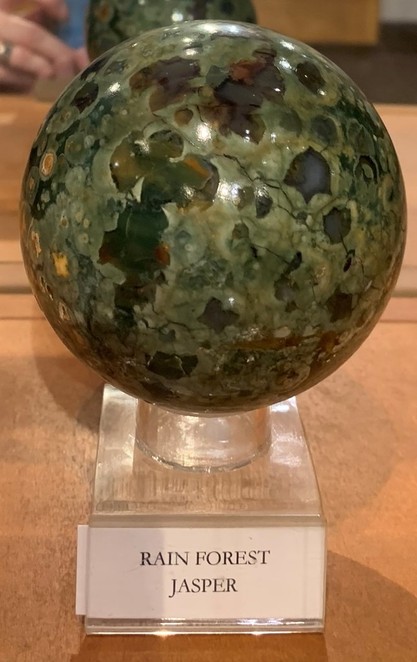
Case B: Jasper // Jasper is an opaque type of Chalcedony (a finely crystalline form of silica composed of quartz and moganite) that can be found in many locations around the world. Jasper is most commonly thought of as red or brown, but can feature many colors including green, yellow, Black, and rarely blue. It is almost always multicolored with different patterns resulting from how the silica consolidated during its formation.
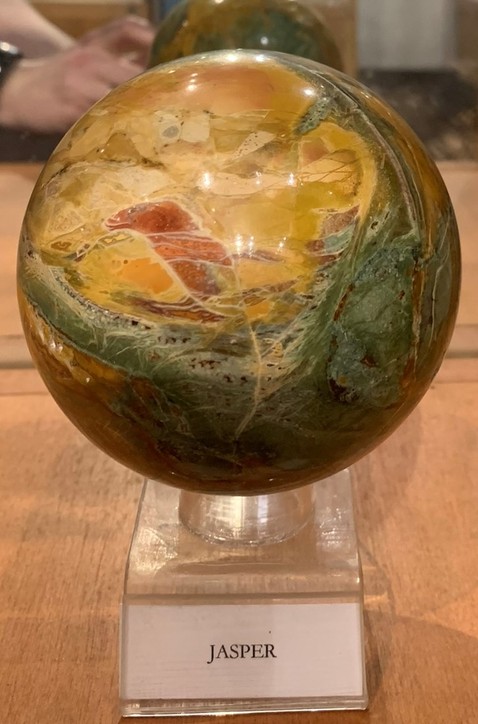
Case C: Bullseye Onyx // Onyx refers to a chalcedony (a finely crystalline form of silica composed of quartz and moganite) that has parallel bands in alternating colors. Commonly onyx is either Black with white banding or red with white banding (called sardonyx). Onyx has been historically used for carving and jewelry, particularly cameos.

Case C: Algae // This is likely an example of a fossil created by layers of microorganisms such as algae or bacteria, called a stromatolite.
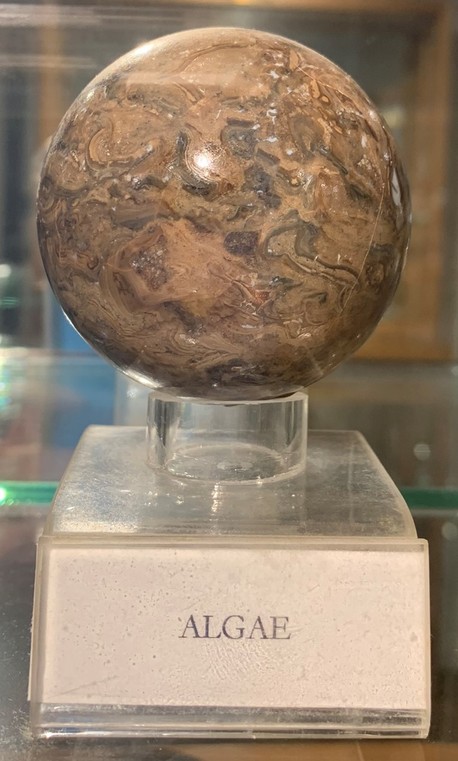
Case C: Copper in Quartz // Deposits and veins of ore such as copper is often mixed with more non-metallic crystalline minerals, such as quartz. The less valuable materials are called gangue minerals and are typically discarded when the precious ore is processed. In this example the copper ore is mixed with quartz as the gangue material.
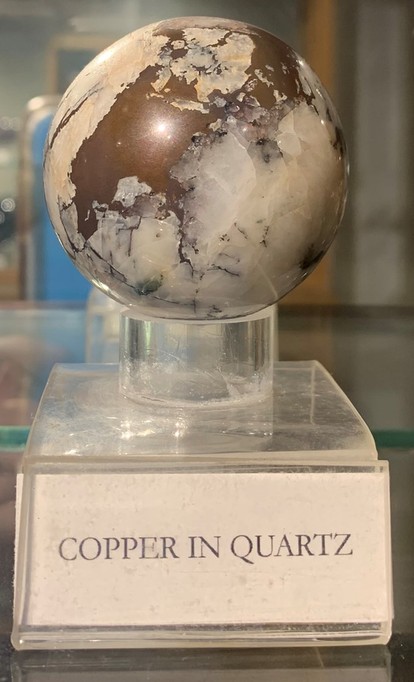
Case C: Unakite // Unakite is a metamorphic rock formed when granite is altered by hydrothermal fluid. The pink material is orthoclase, the green is epidote, and unakite typically also contains clear or milky quartz. It was first discovered in the Unaka mountain range in North Carolina and Tennessee, which the stone was named after.
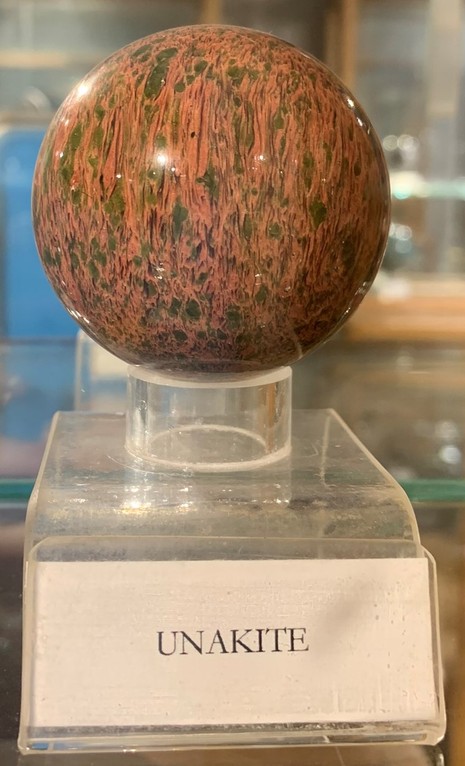
Case C: Norwegian Moonstone // Norwegian Moonstone is also called Larvikite after the Larvik region of Norway where it was found. It is an igneous rock formed by slow-cooling magma and is made iridescent by feldspar crystals. It is sometimes called “blue pearl granite” when used in the facades of buildings, although it is technically not a granite stone.

Case C: Llanite // Llanite is also known as rhyolite porphyry and it is a base of pink and brown feldspar with crystals of blue quartz. Blue is a rare quartz color. Llanite is only found in Llano County, Texas after which the stone is named.

Case C: Ohio Flint // Flint is a hard and resilient sedimentary rock (a form of microcrystalline quartz) that has been used since early human societies to make sharp tools and weapons. Ohio Flint refers to a specific type of flint found in Flint Ridge in eastern Ohio. This flint was highly sought after due to its distinct colors and patterns. Native Americans traveled long distances to acquire Ohio Flint and traded Ohio Flint pieces along widespread trading networks.

Case C: Snowflake Obsidian // Obsidian is a Black volcanic glass that forms when molten rock cools rapidly and it is typically found along the edges of a lava flow or where lava is cooled by air or water. Over time, obsidian can begin to crystalize and this appears as white or gray crystal clusters. Obsidian with these clusters is known as “snowflake obsidian.”
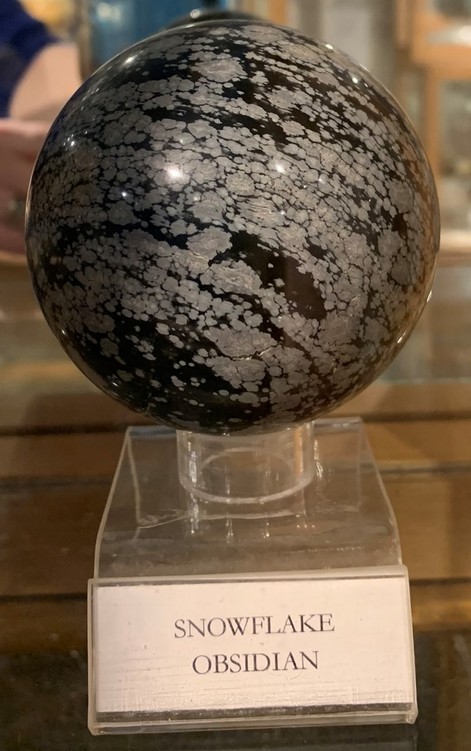
Case C: Leopard Skin Agate // Leopard Skin is made of many different minerals that create patterns that look like a leopard. There is some disagreement over what this stone is. It is sometimes referred to as a jasper. It is also possibly a rhyolite where as the materials were exposed to hot water and pressure minerals were dissolved and/or deposited, creating the spotted patterns.
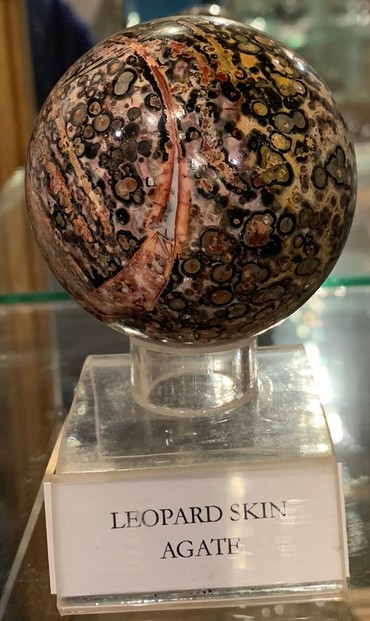
Case C: Zebra Agate // Zebra Stone was likely formed as layers of mud deposits were compressed over time. Typically Zebra Stone has bands of Black and white, but can also come in greens, browns, or reds. It is sometimes called Zebra Agate, Zebra Marble, or Zebra Jasper.
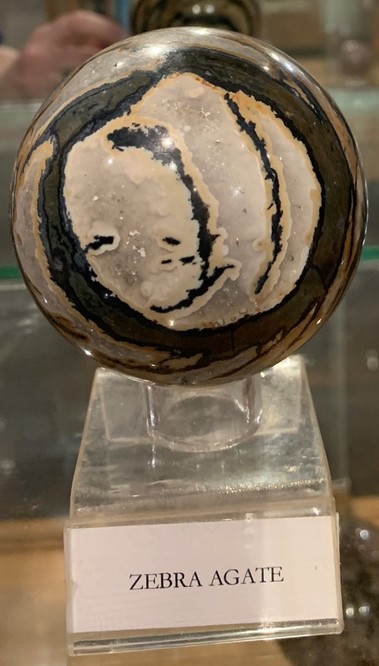
Case C: Aventurine // Aventurine is a type of translucent quartz that includes small particles that impart different colors and a sparkly appearance (known as “aventurescence”). Green is the most common color of aventurine, caused by inclusions of fuchsite, a green chromium-rich mica. Inclusions of different materials can cause aventurine to be orange, yellow, red, pink, brow, white, gray, and blue.
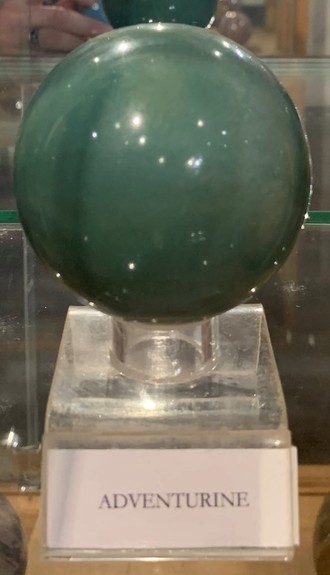
Case C: Bloodstone // Bloodstone is a type of chalcedony, a finely crystalline form of silica composed of quartz and moganite, that is typically dark green in color with red spots. The green coloring is thought to be from particles of chlorite, amphibole, and pyroxene while the typical red splashes are from iron oxide minerals. When colors other than red dominate the piece, such as in this example, it is called “fancy jasper.”

Case C: Birdseye Marble // This material has been labeled a marble within the building industry, but it is actually a limestone. The “birdseye” markings were created by algae that grew around organic materials such as snail shells and twigs.
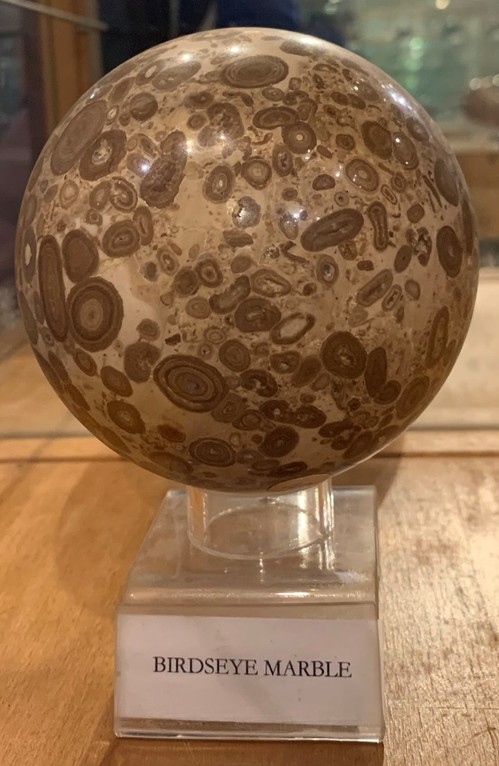
Case C: Rhodonite // Rhodonite is a pink to red mineral that is typically composed of iron, magnesium, and calcium. It is often found in combination with Black manganese oxides which fill in the spaces between the crystal structure. Rhodonite is relatively uncommon and transparent crystals are highly sought by collectors, although the gemstone is too fragile for use in most jewelry. Rhodonite was made the state gemstone of Massachusetts in 1979.
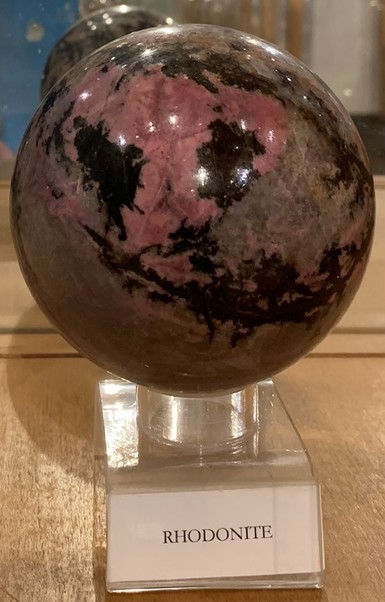
Case C: Mexican Onyx // Mexican Onyx is a type of travertine, a banded limestone that usually forms in heated alkaline water at the surface or as stalactites/stalagmites in caverns. In a pure state travertine is white, but the other minerals present in each band gives it its coloration (cream, tan, green, or brown). Mexican Onyx is particularly durable and is used in sculpture or interior design.
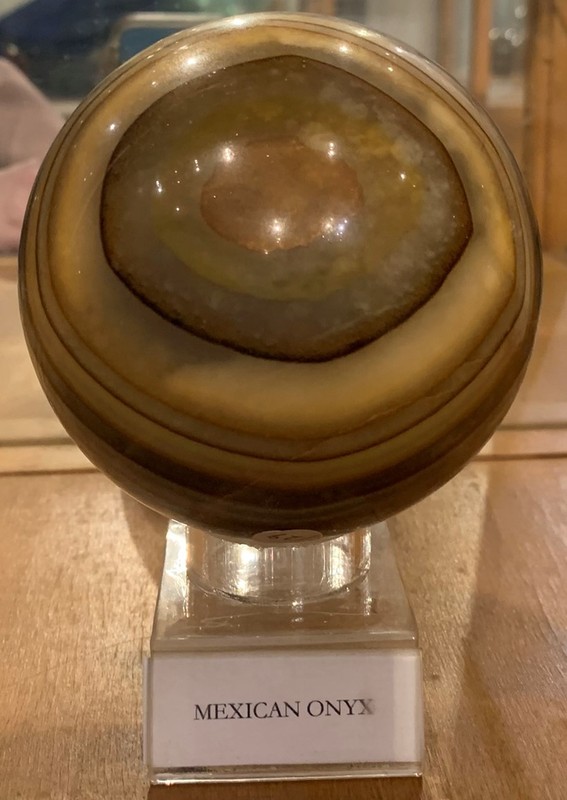
Backstory and Context
Text-to-speech Audio
Case Sponsorships (counter-clockwise starting at the first case on the right):
Case A: Mr. and Mrs. John M. Crane
Case B: Mr. and Mrs. George “Sooner” Shelton & Mrs. Marie “Lucky” Monroe
Case C: Mr. and Mrs. Roy J. Waychoff ‘38
Case D: In Honor of James T. Hill, by his parents Mr. and Mrs. W. Ralph Hill
Case E: Robert Bradford ‘39
Case F: W. Ralph and Irene Miller Hill ‘52
Case G: Clarence and Noraetta Rockwell ‘25
Case H: Mr. and Mrs. Benjamin F. Donley ‘35
